Author: Zach Pandl, Michael Zhao, Grayscale; Translator: Deng Tong, Golden Finance
Abstract
The Ethereum network is the leading smart contract blockchain in terms of market capitalization and total locked value[1], and it hosts a rich array of applications, many of which offer their own investable tokens. However, the Ethereum ecosystem is highly diverse, and each token has unique fundamentals.
When examining the broader ecosystem, one might focus on tokens that exhibit strong fundamental characteristics. These factors might include strong user engagement, transparent value creation mechanisms, and controlled supply growth. In the Ethereum ecosystem, some notable assets that exhibit these characteristics are tokens associated with decentralized financial applications, such as AAVE, MKR, and UNI, as well as LDO associated with staking applications.
The design of the Ethereum network means that most activity on the platform is tied to its native token, Ether (ETH). As a result, the value of ETH tends to reflect the overall activity and growth of the Ethereum ecosystem. The relationship between network usage and token value is a notable aspect of Ethereum’s economic model.
ETH beta strategies, which seek to mimic the performance of ETH using alternative tokens, have underperformed compared to holding ETH directly, as we show in this analysis (Figure 4). This is because most alternative tokens have lagged ETH, with only a few outperforming it. An alternative approach is to diversify across multiple promising projects rather than focusing on a single alternative token.
At its core, Ethereum is a blockchain-based platform that enables developers to build and deploy smart contracts and decentralized applications (dApps). This functionality has spawned a rich ecosystem of projects spanning a variety of areas, including decentralized finance (DeFi), non-fungible tokens (NFTs), and gaming. Many of these projects have issued their own tokens, expanding the cryptoasset ecosystem.
However, investors must be aware that assets in the Ethereum ecosystem are far from uniform. Tokens can vary widely in terms of use cases, supply inflation, historical volatility, and value accrual mechanisms. Some tokens are used as governance tokens for decentralized autonomous organizations (DAOs), others are used as utility tokens in specific applications, and still others are used as representations of real-world assets.
Exploring the ETH Ecosystem
While the Ethereum ecosystem includes tens of thousands of tokens[2], in this report we focus on a key set of assets specified in Grayscale Crypto Sectors — a framework for systematically categorizing digital assets and related index series. These assets represent various aspects of the Ethereum ecosystem, from DeFi protocols to layer 2 solutions and infrastructure projects (Figure 1)[3].
Chart 1: Ethereum Ecosystem Tokens vs. Grayscale Crypto Sectors

Given the complexity of the ecosystem, we can categorize the main components based on Grayscale Crypto Sectors data as follows (for more background on the terminology, see the Grayscale Glossary):
Layer 2 (L2) solutions, such as Polygon (MATIC), Arbitrum (ARB), and Optimism (OP), aims to improve Ethereum’s scalability by processing transactions off-chain, aiming to increase speed and reduce fees while keeping the network secure.
Financial applications leverage smart contracts to provide financial services without the need for traditional intermediaries. Notable examples include leading decentralized exchange Uniswap (UNI), major lending platform Aave (AAVE), and MakerDAO (MKR), the protocol behind the DAI stablecoin.
Other applications include a wide range of services that support the broader ecosystem. For example, the Ethereum Name Service (ENS) provides a distributed naming system. In the NFT space, marketplaces like Blur have gained traction among traders. Finally, while meme tokens such as Shiba Inu (SHIB) are not a core feature of Ethereum, they have become an important part of the ecosystem in terms of market capitalization and community engagement[4].
The “High Beta” Argument
Crypto-native investors sometimes view ecosystem assets as a “high beta” way to invest in Ethereum’s growth. This view is not without merit, as many ecosystem assets do show high short-term correlation with Ethereum’s year-to-date (YTD) returns (Exhibit 2). However, this view oversimplifies the complexity of these assets. Each ecosystem token has unique functionality and should be evaluated individually.
Figure 2: Ethereum ecosystem tokens tend to remain correlated with ETH year-to-date
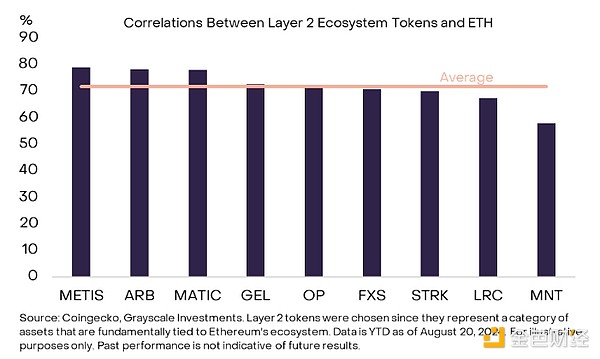
The performance of select assets this year highlights that short-term correlations may not be a good guide to an asset's medium-term performance. For example, ETH itself has appreciated 14% year-to-date. Meanwhile, ARB and MATIC (two relatively large Layer 2 solutions with high short-term correlations to ETH) have actually fallen 54% and 65%% respectively (Figure 3). Although these protocols are deeply integrated and may share many of the same users, the fundamentals of the tokens and thus the price returns can be very different.
Figure 3: Some notable Ethereum ecosystem tokens have underperformed ETH so far this year
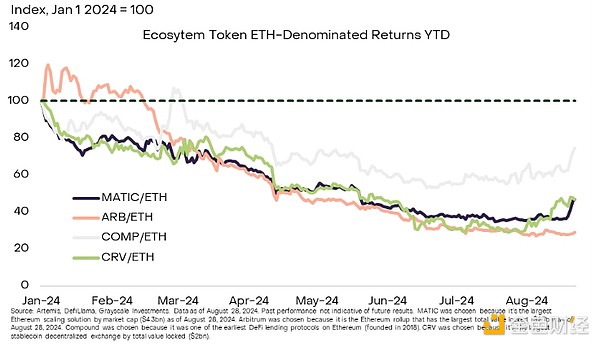
Token Diversity
The Ethereum ecosystem is diverse, with assets differing significantly across multiple dimensions (Figure 4):
Figure 4: Ethereum ecosystem assets differ significantly based on use case and fundamentals
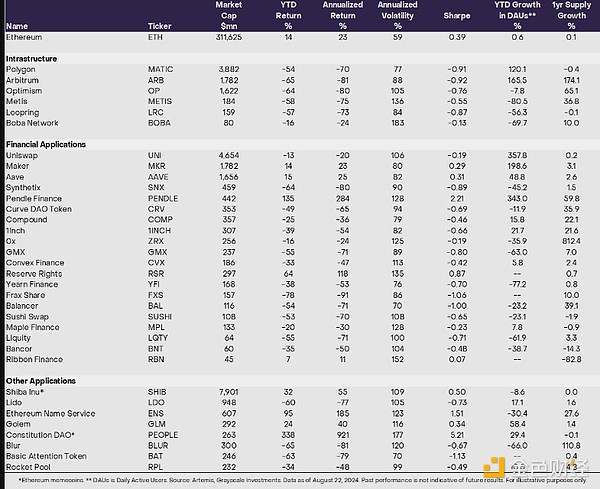
Volatility and risk-adjusted returns for the Ethereum ecosystem show that tokens generally exhibit higher volatility compared to ETH, reflecting ETH’s status as a larger and more mature asset. As a result, only a few ecosystem tokens are able to achieve higher Sharpe ratios than ETH itself[5], highlighting the challenge of outperforming the ecosystem’s underlying assets on a risk-adjusted basis.
Ethereum ecosystem tokens exhibit a diverse supply growth pattern, diverging from ETH’s (primarily) deflationary model[6]. New projects often use high initial inflation to promote adoption and fund development, while mature projects may have a reduced or fixed supply schedule.Some tokens implement adaptive mechanisms that adjust supply based on usage or market conditions. These inflation strategies can significantly impact the long-term value of a token. High inflation can depress prices if demand growth is not matched, while a well-designed schedule can help support sustainable growth. Token supply growth patterns often reflect a project's maturity and value creation process.
Specific application activity trends measured by key metrics such as total value locked (TVL), daily active users, transaction volume, and fees generated can indicate a project's traction and economic viability. For example, rising TVL in a DeFi protocol may indicate increased user trust and capital efficiency, while an increase in transaction fees may indicate high demand for the service. However, these metrics should be interpreted in context; a layer 2 solution may prioritize low fees and high transaction volume, while a lending platform may focus on TVL growth. Additionally, trends in these metrics can reveal competitive dynamics in specific areas of the Ethereum ecosystem. Strong on-chain metrics do not always directly correlate to token price appreciation, as seen in some cases where protocols with high TVL or fee generation may still experience disappointing token performance due to factors such as token distribution or market sentiment.
Performance Comparison
Figure 5: ETH outperforms average and median
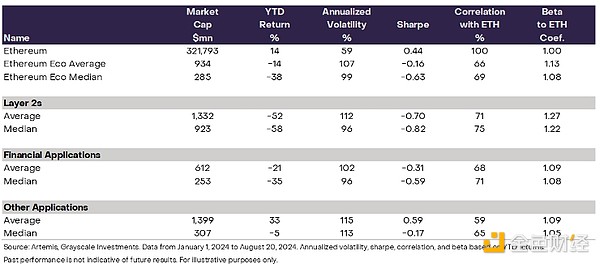
ETH has outperformed its ecosystem tokens in both average and median cumulative returns so far in 2024 (Figure 5). ETH has also shown better risk-adjusted performance, as reflected in a higher Sharpe ratio. However, looking at long-term historical data, the picture is more nuanced. During certain bull runs, some Ethereum ecosystem tokens have outperformed ETH on average. For example, during the 2020-2021 bull run, meme tokens such as SHIB significantly outperformed ETH[7], boosting the average return of the ecosystem token basket.
Year-to-date, specific tokens such as ConstitutionDAO (which we also consider a memecoin) and ENS have been the main contributors to the outperformance of the Other Applications category. In contrast, Layer 2 solutions and financial applications have underperformed ETH during this period. Grayscale Research believes that the potential for excess returns in ecosystem tokens appears to be concentrated in a small number of outperforming assets.
Year-to-date, ETH has tended to outperform its ecosystem tokens, both on average and on the median. However, a small number of standout tokens in the ecosystem could outperform ETH (Figure 4). This analysis shows that while ecosystem tokens can offer opportunities for significant gains, these opportunities are not evenly distributed. Historically, ETH has performed more consistently over longer periods of time.
Given the distribution of performance of ecosystem tokens, a basket of ecosystem assets can provide exposure to potential outperformers while helping to mitigate the risk of selecting underperformers.
Asset Selection Approach
While a diversified portfolio of Ethereum ecosystem assets can be a viable investment strategy, a more targeted approach that focuses on specific asset selections may produce better results - albeit while introducing more idiosyncratic risks. This approach involves identifying assets with good fundamentals and/or potential positive catalysts. Key considerations for asset selection include strong or improving fundamentals (e.g. usage metrics, market leadership, and innovative features), reasonable inflation rates, and price trends.
Some tokens display strong fundamentals but have experienced recent poor price performance, potentially offering attractive entry points. For example, UNI (Uniswap) has demonstrated high usage as a key DeFi primitive but has experienced range-bound price action. Similarly, LDO (Lido) has led in liquidity staking and has a high TVL to market cap ratio despite poor price performance. Other tokens such as MKR (Maker) and AAVE have performed well on both metrics, with MKR accounting for nearly 40% of Ethereum’s DeFi profits[8] and holding the largest portfolio of real-world assets, while AAVE has achieved record user engagement with over $11 billion in TVL across 14 active markets. [9]
Figure 6: Some tokens exhibit strong protocol fundamentals but weak relative price action
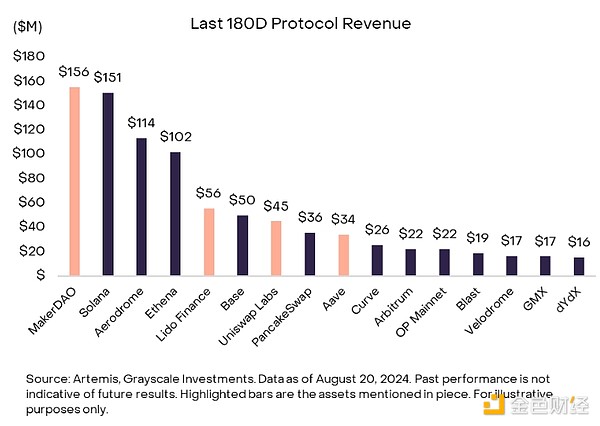
It is also important to be cautious with certain assets. Potential considerations may include tokens with limited utility beyond governance, especially when their market cap significantly exceeds the value of the assets they manage. Projects with declining user bases or persistently negative fees may indicate declining relevance or an unsustainable economic model. Large, regular token unlock events can also help generate selling pressure and volatility. Finally, assets with large market caps but relatively small TVL or lack of obvious growth catalysts tend to be overvalued. To Grayscale Research, these characteristics often indicate that a token’s current valuation is inconsistent with its fundamental utility or growth prospects.
When evaluating Ethereum ecosystem token projects that have faded or failed, more than just current success can be important information — in other words, controlling for survivorship bias. For example, once-popular projects like Augur have seen significant declines in usage and relevance over time. Many tokens from the 2017-2018 ICO boom have lost relevance entirely. If we only consider the current major players, we may overestimate overall success, underestimate risk, and misunderstand the true factors behind a project’s success or failure.
This strategic approach seeks to identify assets with real utility, a growing user base, and valid token economics that may outperform simple basket strategies. However, it requires ongoing research and regular portfolio rebalancing.
Conclusion
From our analysis of Ethereum ecosystem assets, we draw several key points. As the platform for many dApps, Ethereum’s native token, ETH, is perhaps the easiest way to participate in the growth of the entire ecosystem. The Ethereum network is the infrastructure for many dApps, but ETH also has several specific advantages: low supply growth, especially after mergers, which is conducive to long-term value preservation; the potential for increased demand for exchange-traded products, as seen with recent approvals and launches; and strong network effects, as Ethereum’s dominance among smart contract platforms continues to attract developers and users (for more details, please refer to our Grayscale: Why Ethereum is Underperforming and What Will Happen in the Future report).
The Ethereum ecosystem is full of innovative projects that may provide more potential upside, but also expose investors to more potential risks. These include DeFi protocols that are revolutionizing financial services, layer 2 solutions that address scalability, and infrastructure projects that support the broader ecosystem. A diversified investment approach (e.g., investing in a basket of assets, such as a select group of top DeFi tokens) can provide broad participation in the growth of the ecosystem while seeking to mitigate certain project-specific risks. Alternatively, a research-based selective approach that carefully selects individual projects based on their fundamentals, utility, and growth prospects may generate higher returns despite higher risk.
References
[1] As of August 27, 2024, Ethereum is the largest smart contract platform by market capitalization and total locked value. Source: Coingecko, DefiLlama
[2] https://coinmarketcap.com/view/ethereum-ecosystem/
[3] Note: Ethereum (ETH) itself has a market capitalization of approximately $319 billion, dwarfing other assets in the ecosystem. Source: Artemis, Grayscale Investments. Data as of August 27, 2024.
[4] As of August 27, 2024, Shiba is ranked 13th by market capitalization. Source: Artemis, Grayscale Investments
[5] The Sharpe ratio compares the return of an investment to its risk. The numerator of the Sharpe ratio is the return, and the denominator is the standard deviation of the returns over the same period.
[6]https://consensys.io/blog/what-is-eip-1559-how-will-it-change-ethereum
[7]https://decrypt.co/89069/bigger-gains-than-bitcoin-or-ethereum-top-crypto-assets-2021
[8] https://www.syncracy.io/writing/makerdao-thesis
[9] https://defillama.com/protocol/aave#information
 Miyuki
Miyuki











